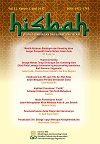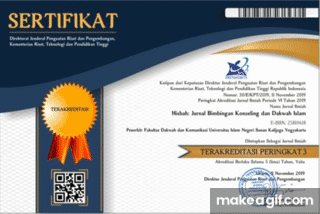FAKTOR-FAKTOR INTERNAL RESILIENSI PENYANDANG DISABILITAS BARU KORBAN BENCANA GEMPA BUMI DI PROVINSI DIY
DOI:
https://doi.org/10.14421/hisbah.2023.201-03Abstract
This article discusses the internal factors of resilience for people with new disabilities who are victims of the earthquake disaster. This research was conducted using a quantitative and qualitative approach (mix method). There were 124 respondents who were involved in this study consisting of people with new disabilities and their families who came from six sub-districts in Bantul Regency. Data was collected by conducting surveys of new persons with disabilities and interviewing families of persons with disabilities. The data that has been collected is then analyzed using SPSS analysis for survey results and coding for interview results. The results of the study show that the internal factors that influence people with disabilities to become resilient are adaptability, problem-solving skills, high optimism, good relationship building skills, and skills to contribute to society.
Keywords: Internal factor, earthquakes, people with new disabilities, resilience.
 Abstract viewed: 399 times
|
Abstract viewed: 399 times
|
 PDF downloaded = 476 times
PDF downloaded = 476 times
References
Afnibar, A. (2017). Konseling Traumatik untuk Korban Gempa dan Resiliensi di Kalangan Masyarakat Minangkabau. PROCEEDING IAIN Batusangkar, 1(1), 46–56.
Aminah, S., Suprihatiningrum, J., & Hanjarwati, A. (2015). PRODADISA “Program Pemberdayaan Difabel Daksa” menuju Percontohan BKD (Balai Kerja Difabel) untuk Meningkatkan Kemandirian dan Life Skill Difabel. INKLUSI, 2(2), 299. https://doi.org/10.14421/ijds.2209
Cimellaro, G. P., Reinhorn, A. M., & Bruneau, M. (2010). Framework for Analytical Quantification of Disaster Resilience. Engineering Structures, 32(11), 3639–3649. https://doi.org/10.1016/j.engstruct.2010.08.008
Damayanti, S. (2011). Disaster and Resilience for the 2007 Flood Event in Part of Sukoharjo Regency. 43(2), 111–122.
Dwi Wahyuni Nurwihastuti. (2013). Geomorphological Analysis On The Earthquake Damage Pattern: A Case Study Of 2006 Earthquake In Bantul, Yogyakarta, Indonesia. UGM.
Gempa, K. (2008). Aksesabilitas pola tata ruang dalam rumah tinggal. 2008, 2008.
Gim, J., & Shin, S. (2022). Disaster Vulnerability and Community Resilience Factors Affecting Post-Disaster Wellness: A Longitudinal Analysis of The Survey on The Change of Life of Disaster Victim. International Journal of Disaster Risk Reduction, 81, 103273. https://doi.org/10.1016/j.ijdrr.2022.103273
Irshad, H., Mumtaz, Z., & Levay, A. (2012). Long-Term Gendered Consequences of Permanent Disabilities Caused by The 2005 Pakistan Earthquake. Disasters, 36(3), 452–464. https://doi.org/10.1111/j.1467-7717.2011.01265.x
Khairulyadi, H., & Nusuary, F. M. (2021). Resiliensi Masyarakat Pasca Bencana Gempa Bumi di Kabupaten Pidie Jaya. Jurnal Ilmiah Mahasiswa FISIP Unsyiah, 6(2). www.jim.unsyiah.ac.id/Fisip
Kusumastuti, R. D., Viverita, Husodo, Z. A., Suardi, L., & Danarsari, D. N. (2014). Developing A Resilience Index Towards Natural Disasters in Indonesia. International Journal of Disaster Risk Reduction, 10, 327–340. https://doi.org/10.1016/j.ijdrr.2014.10.007
Larasati, T., & Savira, S. I. (2019). Resiliensi pada Penyandang Tunadaksa akibat Kecelakaan. Jurnal Penelitian Psikologi, 06(05), 1–7.
Mahmud, S., & Azizah, A. (2020). Perempuan dan Resiliensi: Potret Korban Gempa dan Tsunami di Pandeglang Banten. Gender Equality: International Journal of Child and Gender Studies, 6(2), 1. https://doi.org/10.22373/equality.v6i2.6836
Mayer, B. (2019). A Review of the Literature on Community Resilience and Disaster Recovery. Current Environmental Health Reports, 6(3), 167–173. https://doi.org/10.1007/s40572-019-00239-3
Nankervis, K. A. (n.d.). Community Disability Services.
Oliva, S., & Lazzeretti, L. (2018). Measuring The Economic Resilience of Natural Disasters: An Analysis of Major Earthquakes in Japan. City, Culture and Society, 15(November 2017), 53–59. https://doi.org/10.1016/j.ccs.2018.05.005
Reivich, K., & Shatte, A. (2002). The Resilience Factor, 7 Essential Skill for Overcoming Life’s Inevitable Obstacles. Random House.
Sanderson, D. (2013). Disasters and Livelihoods Cities ,. 2(4), 49–58.
Saputra, A., Diponegoro, A., & Urbayatun, S. (2023). Resiliensi pada Penyintas Pasca Gempa Bumi Lombok. Psyche: Jurnal Psikologi, 5(2), 203–233. https://doi.org/10.36269/psyche.v5i2.1362
Sasmita, N. O., & Afriyenti, L. U. (2019). Resiliensi Pascabencana Tsunami. INSAN Jurnal Psikologi Dan Kesehatan Mental, 4(2), 94. https://doi.org/10.20473/jpkm.v4i22019.94-101
Setyaningrum, N., & Rumagutawan, R. (2018). Tingkat Pengetahuan Penanggulangan Bencana dan Kesiapsiagaan Bencana Gempa Bumi pada Kepala Keluarga di Dusun Kiringan Canden Jetis Bantul Yogyakarta. Health Sciences and Pharmacy Journal, 2(3), 103. https://doi.org/10.32504/hspj.v2i3.44
Smith, F., Doyle, N., Martin, T., & Andyka, V. (n.d.). A Handbook On Mainstreaming Disability Acknowledgements This book was written by Daniel Jones and Li Webster , with additional material written by. 44(0).
Society, C., For, E., & Process, I. N. D. (n.d.). Civil Society Engagement For Mainstreaming Disability.
Truffino, J. C. (2010). Resilience: An approach to the concept. Revista de Psiquiatría y Salud Mental (English Edition), 3(4), 145–151. https://doi.org/10.1016/S2173-5050(10)70024-8
Wibowo, Y. A., Ronggowulan, L., Fatonah, A., & Fajariyah, R. A. A. (2021). Membangun Masyarakat Tangguh Bencana Melalui Sosialisasi dan Edukasi Modal Sosial Di Kabupaten Klaten. Abdi Geomedisains, 68–78. https://doi.org/10.23917/abdigeomedisains.v1i2.198
Williams, R., & Drury, J. (2009). Psychosocial Resilience and Its Influence on Managing Mass Emergencies and Disasters. Psychiatry, 8(8), 293–296. https://doi.org/10.1016/j.mppsy.2009.04.019
Zhang, X., Song, J., Peng, J., & Wu, J. (2019). Landslides-Oriented Urban Disaster Resilience Assessment—A Case Study in ShenZhen, China. Science of The Total Environment, 661, 95–106. https://doi.org/10.1016/j.scitotenv.2018.12.074

Downloads
Published
Issue
Section
License
Authors who publish with this journal agree to the following terms:
- Authors retain copyright and grant the journal right of first publication with the work simultaneously licensed under a Creative Commons Attribution License that allows others to share the work with an acknowledgement of the work's authorship and initial publication in this journal.
- Authors are able to enter into separate, additional contractual arrangements for the non-exclusive distribution of the journal's published version of the work (e.g., post it to an institutional repository or publish it in a book), with an acknowledgement of its initial publication in this journal.
- Authors are permitted and encouraged to post their work online (e.g., in institutional repositories or on their website) prior to and during the submission process, as it can lead to productive exchanges, as well as earlier and greater citation of published work.











